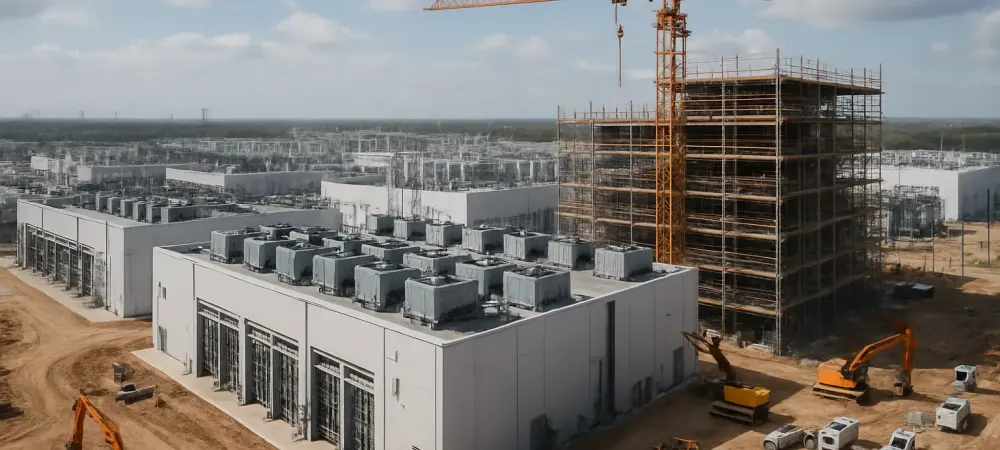Setting the Stage for AI Infrastructure Dominance
In an era where artificial intelligence is reshaping industries at an unprecedented pace, the global demand for specialized data centers has surged to staggering heights, with market estimates projecting a tripling of capacity needs by the end of this decade. This pressing challenge has thrust companies like Volt, a Netherlands-based AI data center firm, into the spotlight as key players in addressing the computational hunger of AI technologies. Headquartered in a nation renowned for its digital connectivity, Volt has embarked on a bold expansion across Europe, the United States, and the Middle East, aiming to redefine the landscape of AI infrastructure. This market analysis delves into the driving forces behind Volt’s multi-continental strategy, examining current trends, capacity projections, and the broader implications for stakeholders in the AI ecosystem. The purpose is to uncover how such initiatives align with global market dynamics and what they signal for the future of tech infrastructure.
Unpacking the AI Data Center Market: Trends, Data, and Forecasts
Surging Demand for AI Computational Power
The AI data center market is experiencing explosive growth as businesses across sectors increasingly rely on machine learning, model training, and inferencing capabilities. Industry reports indicate that the global AI infrastructure market is expected to expand at a compound annual growth rate of over 25% from this year through 2030, fueled by the proliferation of generative AI tools and data-intensive applications. This surge is not merely a trend but a fundamental shift, as traditional cloud computing facilities struggle to meet the specialized requirements of AI workloads, such as high-performance GPUs and low-latency processing. Volt’s emergence in this space is timely, capitalizing on a critical gap where demand far outstrips supply, particularly in regions with robust digital ecosystems like Europe.
Regional Market Dynamics and Volt’s Strategic Positioning
Focusing on Europe, the Netherlands stands out as a linchpin for digital infrastructure, thanks to its strategic location and advanced connectivity, making it a prime hub for Volt’s operations. The company has initiated projects in Amsterdam with an initial 14MW capacity at a prominent facility, while planning further expansions totaling 42MW in nearby developments. Beyond Dutch borders, a joint venture in Poland targets a capacity of 30 to 100MW near Warsaw, with construction slated to begin next year. However, regulatory constraints, such as local moratoriums on new data center builds, pose challenges to scaling in key European markets, pushing firms like Volt to innovate within tight frameworks. These regional dynamics underscore a broader market tension between infrastructure needs and policy limitations, a balance Volt navigates with calculated partnerships and phased rollouts.
Global Expansion and Competitive Landscape
Venturing into North America and the Middle East, Volt is targeting high-growth markets with distinct characteristics, reflecting a nuanced understanding of global demand patterns. In Dallas, Texas, discussions are underway for a massive 400MW space in a data center under construction, positioning the company in one of the US’s most vibrant tech corridors. Similarly, a 129MW project in the United Arab Emirates highlights Volt’s intent to tap into the Middle East’s accelerating digital transformation, though specifics remain undisclosed. These moves place Volt in direct competition with established data center giants, while geopolitical risks and varying regulatory environments add layers of complexity to its expansion strategy. Market analysis suggests that success in these regions hinges on adaptability and localized partnerships, areas where Volt appears to be laying strong groundwork.
Technological Innovations and Market Differentiators
A deeper look into Volt’s offerings reveals a competitive edge in the AI data center market, as the company provides a spectrum of services from basic powered shell solutions to fully managed AI platforms. Access to cutting-edge GPUs from industry leaders like Nvidia and AMD positions Volt as a critical enabler for AI-driven enterprises facing hardware shortages. Moreover, its pursuit of a role in hosting one of the European Union’s planned 300MW AI gigafactories signals an ambition to anchor Europe’s computational future. Market observers note that such gigafactories could shift the continent’s tech capabilities, creating a ripple effect on innovation and investment. Volt’s focus on scalability and specialization aligns with emerging trends toward hyper-efficient, AI-tailored facilities, setting a benchmark for competitors.
Future Projections: Opportunities and Challenges Ahead
Looking toward the horizon, the AI data center market is poised for transformative shifts, with projections indicating a tripling of demand for specialized infrastructure by 2030. Key trends include a push for localized data centers to comply with data sovereignty laws and reduce latency, alongside advancements in cooling technologies to manage the energy intensity of AI workloads. Volt’s multi-continental approach positions it favorably to leverage these opportunities, though challenges such as rising energy costs and sustainability pressures loom large. Industry forecasts suggest that companies embracing green technologies and modular designs will lead the next wave of growth, a direction Volt must consider to maintain its momentum. The market’s evolution will likely favor agile players capable of balancing innovation with operational resilience, a test Volt is already undertaking.
Reflecting on Volt’s Market Impact and Strategic Pathways
Looking back, Volt’s strategic foray into the AI data center market marked a pivotal moment in addressing the global surge in demand for computational capacity, with its expansions across three continents highlighting both ambition and adaptability. The analysis revealed how regional strengths, like the Netherlands’ digital prowess, intertwined with international opportunities in the US and Middle East, shaped a robust growth trajectory despite regulatory and competitive hurdles. For businesses and policymakers, the takeaway is clear: partnering with innovative providers like Volt offers a pathway to harness AI’s potential while navigating market complexities. Moving forward, stakeholders should prioritize investments in sustainable infrastructure and advocate for policies that ease capacity constraints without compromising environmental goals. Additionally, exploring collaborative models for gigafactory projects could amplify regional tech capabilities, ensuring that the next chapter of AI innovation builds on a foundation of shared progress.

